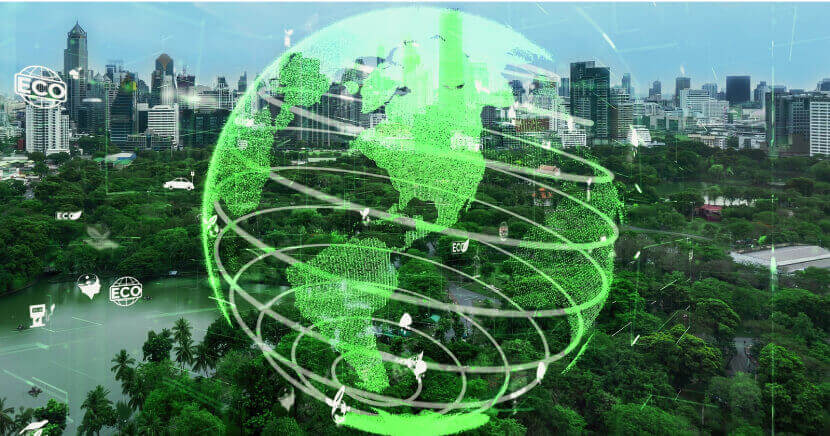In a few previous blog posts, we've explored the connection between libraries and environmental sustainability — in particular, the key role that many libraries play in helping their communities meet sustainable development goals and address the climate crisis.
In 2019, the American Library Association adopted sustainability as a core value of librarianship, noting that this consists of practices that are environmentally sound, economically feasible and socially equitable (this is known as the "Triple Bottom Line"):
Libraries play an important and unique role in promoting community awareness about resilience, climate change and a sustainable future. They are also leading by example by taking steps to reduce their environmental footprint.
Libraries can provide greener information resources
Library services and resources can and should be planned around environmentally sound and socially equitable principles. For example, embracing digital tools like PressReader, which provides searchable, up-to-date editorial content from around the globe, can help a library reduce its environmental impact while serving the needs of diverse members of their communities.
Integrating access to over 7,000 global newspapers and periodicals — either on the branch's computers or the user's own device — expands the library’s offerings and gives users a world of information that won’t cost the earth. At branches that offer PressReader, librarians can also help interested patrons find sustainability-focused publications available on the platform.
See also:
Reducing your library's environmental footprint
This past July, the American Library Association and the Sustainable Libraries Initiative (SLI) published The National Climate Action Strategy for Libraries Implementation Guide, which asked library leaders to consider the question "How has your library already worked to reduce its carbon footprint?"
For example, has your library worked to reduce energy consumption through an energy audit, tightening up the building envelope, or switching to renewable energy? If your library doesn’t control its own space, has your library worked to reduce the amount of “stuff” it purchases (i.e. office supplies, program materials) or made operational choices to decrease transportation costs for people and things to the library?
Later on in this article we will take a look at some key considerations when it comes to designing and constructing new library facilities. However, we also recognize that for most libraries, creating a new branch from the ground up isn't really an economically feasible possibility.
So let's start by exploring what you can do today to reduce your existing library's environmental footprint.
A good first step, according to the ALA/SLI guide we cited above, is to benchmark your current greenhouse gas emissions. There are a number of tools for doing this, including the SLI's own CO2 Emissions Calculator.
After you have done that, you can set goals and determine what solutions might help your library achieve carbon neutrality.
Consider, for instance, the energy used in your library, and explore the following questions:
-
Where does the energy come from to electrify, heat, and cool your facility?
-
What are your options for switching to renewable energy sources to decarbonize the energy source?
-
How are the data centers that provide your online services powered?
Embracing biophilic design principles
Consider also incorporating elements of biophilic design, as described in a Metropolis article by the late social ecology researcher Stephen Kellert:
Biophilic design seeks to connect our inherent need to affiliate with nature in the modern built environment. An extension of the theory of biophilia, biophilic design recognizes that our species has evolved for more than 99% of its history in adaptive response to the natural world and not to human created or artificial forces. We became biologically encoded to associate with natural features and processes. Rather than being vestigial — or relevant to a world that no longer exists — this need is thought to remain instrumental to people’s physical and mental health, fitness, and well-being.
The fundamental goal of biophilic design, according to Kellert, is "to create good habitat for people as biological organisms inhabiting modern structures, landscapes, and communities".
Implementing biophilic design principles in existing library buildings can support sustainability goals by enhancing energy efficiency, promoting environmental stewardship and improving the well-being of both patrons and staff.
Here are a few suggestions:
Energy-efficient natural lighting
Retrofit windows and skylights with energy-efficient glazing to maximize natural light while minimizing heat loss or gain. Install light shelves to direct daylight deeper into the library space.
Integrate daylight-responsive sensors to adjust artificial lighting based on the availability of natural light, reducing energy consumption.
Sustainable indoor greenery
Select indoor plants that require minimal maintenance, and can thrive in the library’s lighting conditions. Use recycled or sustainably sourced planters.
Incorporate plants that naturally purify the air, reducing the need for energy-intensive air filtration systems.
Use of recycled and sustainable resources
When renovating, use recycled or sustainably sourced supplies, such as reclaimed wood, recycled metal or bamboo. Opt for nontoxic paints and finishes.
Choose furniture made from natural or recycled materials that are durable and long-lasting, reducing the need for frequent replacements.
Conserving water through natural elements
Install systems to collect and use rainwater for irrigating indoor plants or outdoor green spaces.
Select native or drought-resistant plants that require less water, aligning with water conservation goals.
Energy-efficient climate control
Install green walls or vertical gardens that can act as natural insulators, helping to regulate indoor temperatures and reduce heating and cooling demands.
Incorporate operable windows or ventilation systems that allow fresh air to circulate, reducing the need for mechanical HVAC systems.
Sustainable landscaping
Use native plant species in any outdoor landscaping to support local ecosystems and reduce the need for irrigation, fertilizers and pesticides.
Replace impermeable surfaces with permeable material to reduce stormwater runoff and support groundwater recharge.
Waste reduction through design
Implement composting systems for plant waste and encourage the community to participate, creating a closed-loop system.
Reduce waste by using upcycled or repurposed supplies for design features, such as furniture or decorative elements.
Designing libraries with sustainability in mind
Designing new public libraries with sustainability in mind can significantly reduce environmental impact while creating a healthy and vibrant space for the community. Here are some key strategies for achieving sustainability in new library designs:
Energy-efficient facility design
Orient the building to maximize natural light and passive solar heating, using large south-facing windows and thermal mass materials to store and slowly release heat.
Incorporate high-quality insulation and airtight construction to minimize energy loss, ensuring the facility maintains a stable internal temperature with minimal energy input.
Renewable energy integration
Install photovoltaic panels on the roof or integrate solar glass windows to generate electricity and reduce reliance on non-renewable energy sources.
Implement geothermal systems that use the earth’s stable temperatures to provide energy-efficient heating and cooling.
Water conservation and management
Design systems to collect and store rainwater for use in irrigation, toilet flushing or cooling systems.
Install low-flow faucets, toilets and showers to reduce water consumption throughout the facility.
Use gray-water recycling systems to treat and reuse wastewater from sinks and showers for irrigation or toilet flushing.
Sustainable material and construction
Use supplies sourced locally to reduce transportation emissions and support the local economy. Choose materials made from recycled content, such as recycled steel or reclaimed wood, and renewable resources like bamboo or cork.
Sustainably sourced wood is a low-carbon construction material that captures and stores carbon. Consider using mass timber (engineered, compressed layers of wood) in structural load-bearing components such as columns and beams.
According to the City of Vancouver, mass timber
-
generates lower carbon emissions compared to conventional construction practices;
-
potentially reduces embodied emissions in construction by 25 to 45%;
-
offers cost-effectiveness, safety, fire resistance and seismic resilience;
-
makes it possible to build parts offsite because wood is lightweight, reducing installation time and costs; and
-
creates local and regional job opportunities.
Green roofing and landscaping
Install green roofs that can absorb rainwater, provide insulation and create habitats for wildlife. These roofs also reduce the heat island effect in urban areas.
Design outdoor spaces with native plants that require less water, fertilizer and maintenance, supporting local ecosystems and biodiversity.
Use permeable paving material to allow rainwater to infiltrate the ground, reducing stormwater runoff and promoting groundwater recharge.
Indoor environmental quality
Maximize the use of natural light through strategically placed windows, skylights and light wells, reducing the need for artificial lighting and improving occupant well-being.
Incorporate plants that improve indoor air quality, and consider advanced air filtration systems that reduce pollutants and allergens.
Flexible and adaptive spaces
Create flexible, modular spaces that can easily adapt to changing needs, reducing the need for future renovations and material use.
Design areas that serve multiple purposes, such as combining reading rooms with community meeting spaces, to maximize space utilization and reduce resource consumption.
Transportation and accessibility
Provide ample bicycle storage, showers and changing facilities to encourage sustainable transportation among staff and visitors.
Locate the library near public transit options and include infrastructure like bus shelters or transit information screens to support eco-friendly commuting.
Sustainability education and community engagement
Integrate sustainability features into the branch’s design in a way that educates visitors, such as interactive displays that explain how the building’s systems work.
Engage the community in the design process, hosting workshops or forums to gather input and educate about the importance of sustainable design.
Certification and benchmarking
Aim for Leadership in Energy and Environmental Design (LEED) certification, or similar standards, to ensure the construction meets high sustainability criteria.
Design the library to achieve net-zero energy use, where it produces as much energy as it consumes, through a combination of energy efficiency and renewable energy sources.
By integrating these strategies into the design of new facilities, libraries can significantly reduce their environmental footprint, provide healthier indoor environments for community members, and serve as models of a more sustainable future.











